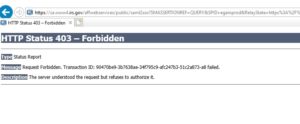If you are a tax professional who does any representation work, do I have news for you…and it’s not good. Yesterday, the IRS made an announcement about redacting information on transcripts. Here’s an excerpt of the announcement:
Moving to better protect taxpayer data, the Internal Revenue Service today announced a new format for individual tax transcripts that will redact personally identifiable information from the Form 1040 series…The following information will be provided on the new transcript:
• Last 4 digits of any SSN listed on the transcript: XXX-XX-1234
• Last 4 digits of any EIN listed on the transcript: XX-XXX-1234
• Last 4 digits of any account or telephone number
• First 4 characters of the last name for any individual
• First 4 characters of a business name
• First 6 characters of the street address, including spaces
• All money amounts, including balance due, interest and penalties
But there’s more information—information not included in this announcement that’s very important if you do any tax representation work. If a tax professional with authorization (either an IRS Power of Attorney or Tax Information Authorization) calls the IRS up and requests a transcript, we can have it faxed to us (if we have a secure fax machine). Effective January 1, 2019, the IRS will no longer fax transcripts; they will only be mailed, and then, apparently only to the taxpayer’s address of record (not to tax professionals with the appropriate authorization). This is a huge problem.
Consider nonfilers–people not in the system. There is no address in the system to mail anything to. This will slow down work and hinder compliance with tax law.
Next, consider taxpayers who are overseas. Mail to locations outside the United States takes much longer and, in many countries, is of dubious security.
Now those of us with access to IRS E-Services will still be able to download transcripts once the CAF Unit processes the authorization (but see below on two additional issues). But when there’s an immediate issue, and the authorization hasn’t been processed, we will have to tell all involved, “We have to wait for the POA to be processed. Please add two weeks additional to your timeline.” I’m sure IRS Revenue Officers, Tax Compliance Officers, and Revenue Agents will appreciate this.
Unfortunately, there are two other major issues with this policy. First, the redaction of Employer Identification Numbers (EINs) will impact efiling and state tax issues. Let’s assume I request a Wage & Income Transcript for John Smith. Today, that transcript will show the full EIN for any issuers of tax documents. That allows tax professionals to prepare returns that can be electronically filed (EINs are required for efiling). In the future, the transcript will just show “xx-xxx9999” as the EIN. If we happen to have a W-2 on file for that employer we’ll be able to use the EIN; otherwise, that tax return will have to be paper filed. This impacts state tax returns, too. Many states mandate efiling, and also mandate that we provide EINs on the tax return. We will be unable to comply with this in the future for impacted clients.
Additionally, business names will be redacted; only the first four characters will be shown. Imagine seeing “ACME xxxxxxxxxxxx xxxxxxxxxxxxx” as the business name. The business address will be redacted (just the first six characters will be shown); our address would be shown as “1919 S”; maybe with the first four characters of our name (CLAY) and those characters you could figure out who we are but I doubt it in a city one-tenth the size of Las Vegas. Basically, when I’m entering W-2s based off a transcript I’ll enter four characters and hope it matches correctly (good luck with that!). As to trying to call someone, how? Clients’ memories of prior years are, much of the time, hazy; the transcripts will be of little use. And many payors listed on information returns are parent companies rather than the payor itself; matching will be near impossible.
(This is also going to make responding to IRS Automated Underreporting Unit (AUR) notices quite interesting. Imagine your client receives such a notice, and all it says is “ACME” and the client says he never worked for ACME. How is a tax professional or the client going to find out the truth? There won’t be near enough information on the notice. You can expect a surge in Tax Court filings in about a year.)
“But Russ,” you ask, “Shouldn’t clients keep good records and all their W-2s (and other tax documents)?” Absolutely, but we have to deal with the world as it is, not how we want it to be. I’ve had two representation clients in the last month who have been victims of casualty losses: One lost all his records because of a fire; the other lost his records due to a flood. And many representation clients simply don’t have the records.
I understand why the IRS is doing this (the security issue) but this is going to make representation clients wait even longer to get their cases resolved, and will make overall compliance worse. It will cause paper filing to increase (not by a huge percentage, but it will still be noticeable) and will impact states, too. Overall, the unintended consequences were not thought out by the IRS.
